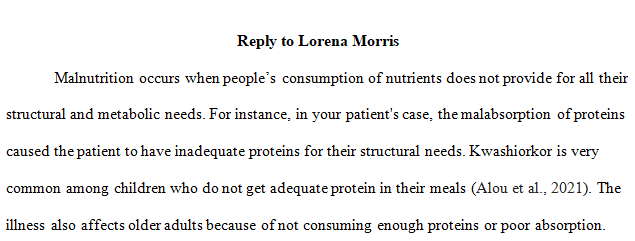An 83-year-old patient living a skilled nursing facility presented to the emergency department. Upon admission
An 83-year-old patient living a skilled nursing facility presented to the emergency department. Upon admission
Main Post
An 83-year-old patient living a skilled nursing facility presented to the emergency department. Upon admission, she was diagnosed with protein malnutrition with a medical history of malabsorption syndrome and difficulty eating due to not having her dentures.
Even though malnutrition can impact humans in so many ways such as delays in neurocognitive development, we have very little genetic understanding on the role genes play on malnutrition (Duggal and Petri, 2018).
Protein malnutrition occurs when the person does not have the adequate intake of nutrients needed, such as protein in this case. According to McCance and Huether (2019), malnutrition is an imbalance between nutrient requirement and nutrient intake. Furthermore, it can also involve the inappropriate absorption and the inappropriate utilization of nutrients. This patient is not taking in enough protein due to her eating difficulties. The patient also has a history of malabsorption syndrome which might prevent her from absorbing all the proper nutrients. Malabsorption syndrome can happen from any imperfection in the intestinal lining, such as in the small intestine, which is where most of the absorption of nutrients occurs. Additionally, this can lead to the impairment of nutrient absorption, impaired motility, and a compromised lymphatic function (Zuvarox & Belletiere, 2022). Protein malnutrition can increase the risk of fractures, delay wound healing, and increase the risk of infections.
McCance and Huether explain that kwashiorkor, also called edematous malnutrition, is a protein deficiency. Physiologically, this malnutrition gives the patient inadequate nutrients such as proteins and the lack of these proteins results in intestinal inflammation hence the swollen abdomen in the patient. Furthermore, the liver swells and pancreatic atrophy occurs because there isn’t any protein to help in the release of lipoprotein. Proteins such as albumin help pull fluid into our vessels and help avoid keeping the fluid in one place, which can cause dependent edema, such as in the patient’s hands and feet. The patient in this scenario presented with generalized edema of her extremities and her abdomen, which are manifestations of kwashiorkor, as indicated in our textbook.
The cells involved in malnutrition are T-cells, which are important for our immune system and help us fight infection and cancer. With malnutrition, specifically protein malnutrition, the patient has a lack of proteins that are important in the development and function of T-cells (Collins, 2020). Since T-cells help fight infection and they are low in a patient with malnutrition, it can increase our chance of getting sick since our immune system may not be at working at its best.
This disease is very common among the elderly and perhaps under diagnosed. Other characteristics would be social determinants, specifically social class and economic standing. Patients who are less stable financially are more apt to eat less healthy foods. Junk foods have fewer useful nutrients, especially protein. Additionally, if the patient was a vegetarian and not sufficiently educated about finding non-meat alternative proteins, this could also be a factor. These characteristics could supplement the understanding of the cause of the malnutrition in the patient.
References
Collins, N. (2020). Dietary regulation of memory T cells. International Journal of Molecular Sciences, 21(12). Retrieved on February 27, 2023, from http://dx.doi.org/10.3390/ijms21124363Links to an external site.
Duggal, P., & Petri, W. A. (2018). Does malnutrition have a genetic component? Annual review of genomics and human genetics, pp. 247–262. https://doi.org/10.1146/annurev-genom-083117-021340Links to an external site.
McCance, K. L. & Huether, S. E. (2019). Pathophysiology: The biologic basis for disease in adults and children. 8th ed., Elsevier Inc.
Zuvarox, T., & Belletieri, C. (2022). Malabsorption syndromes. In : StatPearls. StatPearlsPublishing. https://www.ncbi.nlm.nih.gov/books/NBK553106/Links to an external site.
Requirements: 1/2 page
Masters Nursing
Answer preview for the paper on ‘An 83-year-old patient living a skilled nursing facility presented to the emergency department. Upon admission’

APA 258 words
Click the purchase button below to download full answer…….
